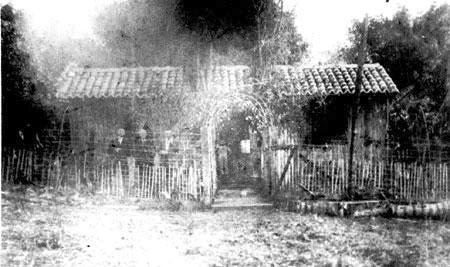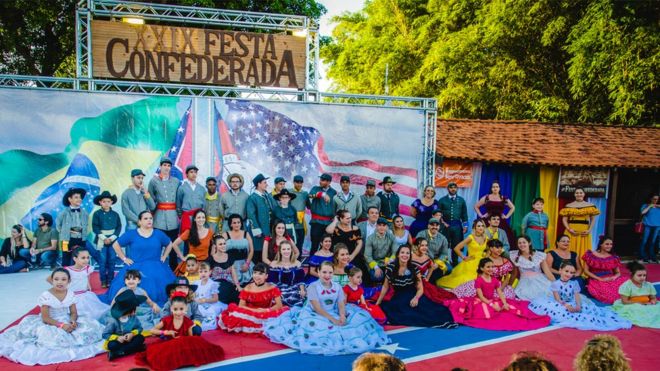Post by Octavio on May 28, 2020 8:37:58 GMT -5
After the American Civil War, many former confederates fled as refugees to Brazil, settling in the Campinas region.
The first Confederate to arrive was named William Hutchison Norris, former Senator on Alabama, who settled in Santa Barbara d'Oeste - at the time, Norris Colony. He introduced watermelon and nut
production in Brazil, as well as some newer farming techniques.
Most of the former Confederates settled in a place that got named "Vila Americana" - American Village - now a medium to big city in São Paulo Countriside.
The confederates not only had good relations with Brazil at the time, but they seen the country as a place where they could keep living as they lived before Lincoln. Rural Brazil wasn't much different from rural CSA back in tbe XIX century.

(Norris' house in Brazil)
The confederates also made a decent production of cotton and cloth, that made the production get more common in the Campinas region and also earned Americana the nickname "Tailor Princess". An American, named Clement Willmont, with some Brazilian entrepeuners, made a manufactory of clothing items at that time as well, and it was one of the reasons that Americana got bigger and rich.
It was at that time that the first Brazilian presbyterian church got founded. As the only cemetery in town was a Roman Catholic one, hte presbyterians would be buried around Norris' farm, where now is a turistic area: The Cemitério do Campo.

In both Americana and Santa Bárbara d'Oeste, there are traditional events that celebrate the Confederate immigration. Those events are called "Festa Confederada" - Confederate Feast - and happens once in a year. People usually wear confederate clothes on the event nad decorate the ity with USA, Brazil and the CSA flags, as well as their city's flag.

(XXIX Confederate Feast - Santa Bárbara d'Oeste - SP)
Those feasts usually bring some debates in Brazilian media: some people claim they celebrate racism and segregation. Many people claim that the Confederate symbols here `must be outlawed and the feasts must be brought to an end.
The locals, on the other hand, claims that this is the city's history and they must lot be erased. They see the CSA symbols as a embodyment of family values and of love and fraternity.
(people in the XXIX Confederate Feast dressed as Confederate Soldiers)
People in Americana and Santa Bárbara d'Oeste take pride on their confederate heritage, and how their ancestors came to Brazil after the Civil War, and they keep fighting to keep their traditions alive.
As the Confederates came to the Campinas Region, many American cultural events started to mix with the caipira culture, common to the area. The Brazilian caipiras were culturally close to the confederates since they also where farmers and lived in places that weren't very industrial. Their cultural events fitted quite well in the caipira ways, and became popular around all the region. As an example, it's common to see rodeos in this region, and they have pretty much the same events and with the same rules as the ones in the USA.
/i.s3.glbimg.com/v1/AUTH_59edd422c0c84a879bd37670ae4f538a/internal_photos/bs/2019/0/a/mDHIboT9GietM2stSVVg/dsc3870.jpg)
(A Rodeo in Barretos - SP)
Altough the Confederate influx wasn't as big as the Italian, they still made a great influence among the Caipira, and are still revered in the cities they helped to settle.
The first Confederate to arrive was named William Hutchison Norris, former Senator on Alabama, who settled in Santa Barbara d'Oeste - at the time, Norris Colony. He introduced watermelon and nut
production in Brazil, as well as some newer farming techniques.
Most of the former Confederates settled in a place that got named "Vila Americana" - American Village - now a medium to big city in São Paulo Countriside.
The confederates not only had good relations with Brazil at the time, but they seen the country as a place where they could keep living as they lived before Lincoln. Rural Brazil wasn't much different from rural CSA back in tbe XIX century.

(Norris' house in Brazil)
The confederates also made a decent production of cotton and cloth, that made the production get more common in the Campinas region and also earned Americana the nickname "Tailor Princess". An American, named Clement Willmont, with some Brazilian entrepeuners, made a manufactory of clothing items at that time as well, and it was one of the reasons that Americana got bigger and rich.
It was at that time that the first Brazilian presbyterian church got founded. As the only cemetery in town was a Roman Catholic one, hte presbyterians would be buried around Norris' farm, where now is a turistic area: The Cemitério do Campo.

In both Americana and Santa Bárbara d'Oeste, there are traditional events that celebrate the Confederate immigration. Those events are called "Festa Confederada" - Confederate Feast - and happens once in a year. People usually wear confederate clothes on the event nad decorate the ity with USA, Brazil and the CSA flags, as well as their city's flag.

(XXIX Confederate Feast - Santa Bárbara d'Oeste - SP)
Those feasts usually bring some debates in Brazilian media: some people claim they celebrate racism and segregation. Many people claim that the Confederate symbols here `must be outlawed and the feasts must be brought to an end.
The locals, on the other hand, claims that this is the city's history and they must lot be erased. They see the CSA symbols as a embodyment of family values and of love and fraternity.

(people in the XXIX Confederate Feast dressed as Confederate Soldiers)
People in Americana and Santa Bárbara d'Oeste take pride on their confederate heritage, and how their ancestors came to Brazil after the Civil War, and they keep fighting to keep their traditions alive.
As the Confederates came to the Campinas Region, many American cultural events started to mix with the caipira culture, common to the area. The Brazilian caipiras were culturally close to the confederates since they also where farmers and lived in places that weren't very industrial. Their cultural events fitted quite well in the caipira ways, and became popular around all the region. As an example, it's common to see rodeos in this region, and they have pretty much the same events and with the same rules as the ones in the USA.
/i.s3.glbimg.com/v1/AUTH_59edd422c0c84a879bd37670ae4f538a/internal_photos/bs/2019/0/a/mDHIboT9GietM2stSVVg/dsc3870.jpg)
(A Rodeo in Barretos - SP)
Altough the Confederate influx wasn't as big as the Italian, they still made a great influence among the Caipira, and are still revered in the cities they helped to settle.






